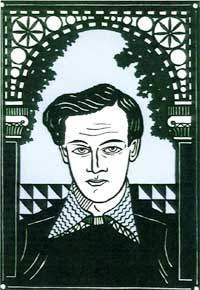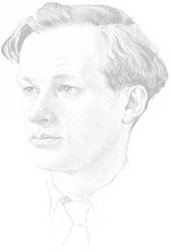JLM was both a prolific and versatile author. Altogether he brought out thirty-four volumes during his lifetime, including works of architectural and general history, biographies, novels and memoirs.
It is however mainly for his diaries that he is now remembered, which have been described as 'one of the treasures of contemporary English literature'. Many have hailed him as the greatest English diarist of the twentieth century, and compared him to Samuel Pepys. As well as providing a wealth of fascinating detail about his work, friendships and attachments, JLM's diaries are remarkable for the sharpness with which he observes the world around him, the candour with which he writes about himself and others, his alternation of tone between the comic and the poignant, and his ability to capture the essence of a scene in a few words.
There were in fact two distinct periods during which he kept a regular diary, separated by more than two decades - 1942-49 and 1971-97. (The reason that he desisted in between - except for a few short periods - is that he did not wish to record the details of an often unhappy marriage.)
JLM edited his 1940s diaries in four volumes appearing between 1975 and 1985, each covering two years, to which he gave titles deriving from Coleridge's poem 'Kubla Khan' - Ancestral Voices, 1942-3 (1975); Prophesying Peace, 1944-5 (1977); Caves of Ice, 1946-7 (1983); and Midway on the Waves, 1948-9 (1985). The first three were published by Chatto & Windus, the fourth by Faber & Faber which proceeded to produce paperback editions of all four. First editions of these volumes now fetch high prices on the second-hand market.
During his last years JLM began editing his later diaries, all published by John Murray. They too were given 'Kubla Khan' titles - A Mingled Measure, 1953-72 (1994); Ancient as the Hills, 1973-4; Through Wood and Dale, 1975-8 (which JLM finished editing just before his death, being published posthumously in 1998).
After JLM's death, his literary executor Michael Bloch completed the editing of his diaries, producing five further volumes - Deep Romantic Chasm, 1979-81 (2000); Holy Dread, 1982-4 (2001); Beneath a Waning Moon, 1983-5 (2003); Ceaseless Turmoil, 1988-92 (2004); and The Milk of Paradise, 1993-97 (2005).
During 2006-2008 John Murray published a new, three-volume edition of the diaries, abridged by Michael Bloch. Since 2003, however, Michael Russell has been reprinting the twelve original volumes in his Clocktower Paperback series, reaching the ninth volume, Holy Dread, in 2008.
All of JLM's diaries - both in the twelve- and three-volume editions - may be purchased from the BOOKSHOP section of this website.
FROM SUSAN HILL'S ARTICLE ON DIARISTS IN THE GUARDIAN
(10 January 2004)
‘If you want to experience the merry-go-round of upper-middle-class life in the 20th century you can do no better than follow Lees-Milne, as sharp-tongued, melancholy, jaundiced and reactionary a commentator as ever lived. He does nothing to ingratiate himself with us, has no desire to be liked any more than he would like us. He hates modern life and times, laments the decline of almost everything, is a ferocious snob. But like all the best diarists and almost in spite of himself, he has the keenest of interests in life, a refusal to be only an old fuddy-duddy; he will try almost anything, from a new film or fashionable play to a young lover...’
OTHER WORKS
Although James Lees-Milne aspired to be a writer from his earliest years, he was almost middle-aged before he got a book into print. His first title, The Age of Adam, was published by Batsford in 1947, when he was thirty-eight. There followed two further works of architectural history, Tudor Renaissance (1951) and The Age of Inigo Jones (1953). Now dated, these books created some excitement at the time. Most previous writing on the subject had been rather technical; and JLM was one of a small number of writers (another being his friend Sacheverell Sitwell) who succeeded in making it accessible to the general reader.
Roman Mornings (1956), a tour of JLM's favourite monuments in that city, won the Heinemann Award, and was followed by a series of books on Baroque architecture. Earls of Creation (1962; reprinted 2001 by Penguin) portrays the architect-noblemen of the eighteenth century. 1964 saw the appearance of JLM's Shell Guide to his native Worcestershire; in this, as in his architectural journalism, he railed against the vandalism of the modern world. St Peter's (1967), despite its coffee table format, was a serous work of scholarship which received the papal imprimatur (ironically just as JLM was drifting away from the Roman Catholic Church).

Jacket design for Faber edition of Another Self (1985).
It is paradoxical that JLM longed for recognition as a novelist; but his one novel to achieve success was unrecognised as a work of fiction, while three other novels - all set in country houses and 'gothick' in character - failed to receive much attention. Heretics in Love (1973), set in a house modelled on JLM's grandmother's, takes incest as its theme. Round the Clock (1978) is based on the idea that the object of affection recoils from it. The Fool of Love (1990) deals with the entanglements which ensue when a German PoW during the First World War seduces first an English schoolboy and then the boy's mother.
1976 saw the publication of JLM's much-praised life of William Beckford, in whose Bath library he had installed himself. For the next fifteen years, he was preoccupied with three major biographies. Harold Nicolson (two vols., 1980-81) deals with the varied career of his friend and hero. The Enigmatic Edwardian (1986) is a biography of Reginald, 2nd Viscount Esher, the éminence grise who ran England with one hand while pursuing adolescent boys with the other. The Bachelor Duke (1991) portrays the 6th Duke of Devonshire, art collector and patron of Sir Joseph Paxton. These works, testifying to JLM's ability to extract the essence from huge collections of papers, combine affection for their subjects with an impish fascination with their foibles. They were all well-received by the critics.
JLM was prolific in his seventies, producing several lesser works between these large projects. The Last Stuarts (1983), a legacy of his Catholic period, is an original work of scholarship which puts forward a Jacobite view of history. Images of Bath (1982), Some Cotswold Country Houses (1987) and Venetian Evenings (1988) testified to a continuing interest in architecture. In his last years he produced two volumes of reminiscences - People & Places (1992), a nostalgic account of his role in the acquisition of various National Trust properties, and Fourteen Friends (1996), a tribute to departed soul-mates.
Most of JLM’s books other than his diaries are now out of print - with the notable exceptions of Another Self, which was reissued by Michael Russell in 2003 and the film rights in which were sold in 2008, and St Peter’s, which has been published on the internet at www.stpetersbasilica.org/Docs/JLM/SaintPeters-1.htm. Some are still available from Amazon via the BOOKSHOP; others can be obtained from www.abebooks.com.
TOP
Home | The Life | The Books | Bookshop | The Play | See & Hear | Visitors Book
